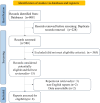Clinical efficacy of exercise therapy for lumbar disc herniation: a systematic review and meta-analysis of randomized controlled trials
- PMID: 40224631
- PMCID: PMC11985520
- DOI: 10.3389/fmed.2025.1531637
Clinical efficacy of exercise therapy for lumbar disc herniation: a systematic review and meta-analysis of randomized controlled trials
Abstract
Background: Lumbar disc herniation (LDH) is mainly characterized by pain and neurological dysfunction resulting from rupture of the fibrous ring of the lumbar disc. The incidence of LDH is increasing year by year, mainly owing to long-term sitting and immobility, improper posture, and reduced physical activity during study and work. The incidence of LDH in young people aged 18-35 years has shown a significant upward trend. LDH is one of the most common causes of back pain, affecting approximately 1-3% of the global population, and it is mainly concentrated in people aged 30-50 years. Exercise therapy, as an economically effective treatment method, can enhance the strength of core muscle groups and effectively alleviate the symptoms of LDH. However, strong evidence that proves the effectiveness of exercise therapy for LDH is still lacking. We conducted a meta-analysis of relevant clinical studies and used statistical methods to scientifically explore the effectiveness of exercise therapy for LDH.
Methods: Four databases were searched, including PubMed, Embase, Web of Science, and Ovid. The search period ended on August 24, 2024. Comparisons were made between the group that used exercise therapy (treatment group) and the group that did not (control group). If heterogeneity among the studies was strong, sensitivity analysis was performed.
Results: Of the 580 articles initially identified, eight (encompassing 611 patients with LDH) were included in the analysis. The results of the meta-analysis demonstrated that the treatment group exhibited superior outcomes in terms of Visual Analog Scale score, Oswestry Disability Index, range of motion, McSensory score, McTotal score, and Short Form-36 score compared with the control group.
Conclusion: Exercise therapy is an economical, effective, and simple adjuvant therapy for patients with LDH. Exercise therapy enhances core muscle strength and lumbar stability, relieves lower back and leg pain, and improves patients' quality of life. However, no consensus on the use of exercise therapy for LDH currently exists, and there are no specific recommendations for exercise intensity, frequency, and activity that are suitable for patients with LDH. More high-quality clinical studies are needed to validate the application of exercise therapy as a treatment for LDH.
Systematic review registration: The protocol was registered on PROSPERO (CRD42024586775).
Keywords: clinical trial; exercise therapy; lumbar disc herniation; meta-analysis; traditional Chinese exercise.
Copyright © 2025 Du, Cui, Peng, Wu, Xu, Mo and Ye.
Conflict of interest statement
The authors declare that the research was conducted in the absence of any commercial or financial relationships that could be construed as a potential conflict of interest.
Figures







Similar articles
-
Effect of traditional Chinese exercise combined with massage on pain and disability in patients with lumbar disc herniation: A multi-center, randomized, controlled, assessor-blinded clinical trial.Front Neurol. 2022 Sep 6;13:952346. doi: 10.3389/fneur.2022.952346. eCollection 2022. Front Neurol. 2022. PMID: 36158965 Free PMC article.
-
Study on the efficacy and safety of the combination of Shi's manual therapy and percutaneous endoscopic lumbar diskectomy for lumbar disc herniation with radiculopathy: study protocol for a multicenter randomized controlled trial.Trials. 2022 Apr 23;23(1):338. doi: 10.1186/s13063-022-06195-y. Trials. 2022. PMID: 35461259 Free PMC article.
-
Percutaneous endoscopic lumbar discectomy compared with other surgeries for lumbar disc herniation: A meta-analysis.Medicine (Baltimore). 2021 Mar 5;100(9):e24747. doi: 10.1097/MD.0000000000024747. Medicine (Baltimore). 2021. PMID: 33655938 Free PMC article.
-
Effects of suspension exercise training in the treatment of lumbar disk herniation: a systematic review and meta-analysis.Front Neurol. 2024 Dec 2;15:1455505. doi: 10.3389/fneur.2024.1455505. eCollection 2024. Front Neurol. 2024. PMID: 39687406 Free PMC article.
-
Study on the safety and efficacy of Fu's subcutaneous needling for the treatment of lumbar disc herniation: a systematic review and meta analysis of randomized controlled trials.Front Neurol. 2025 Apr 15;16:1509291. doi: 10.3389/fneur.2025.1509291. eCollection 2025. Front Neurol. 2025. PMID: 40303884 Free PMC article.
Cited by
-
Percutaneous Electrolysis for Musculoskeletal Disorders Management in Rehabilitation Settings: A Systematic Review.Healthcare (Basel). 2025 Jul 23;13(15):1793. doi: 10.3390/healthcare13151793. Healthcare (Basel). 2025. PMID: 40805826 Free PMC article. Review.
-
Open-source customizable website to follow-up physical rehabilitation of cardiovascular patients at home.Front Cardiovasc Med. 2025 Jul 25;12:1633106. doi: 10.3389/fcvm.2025.1633106. eCollection 2025. Front Cardiovasc Med. 2025. PMID: 40787232 Free PMC article.
References
-
- De Cicco F. L., Camino Willhuber G. O., (2024). "Nucleus pulposus herniation," in StatPearls. Treasure Island (FL) Ineligible companies. Disclosure: Gaston Camino Willhuber declares no relevant financial relationships with ineligible companies: StatPearls publishing. Copyright © 2024, StatPearls Publishing LLC.
-
- Al Qaraghli M. I., De Jesus O., (2024). "Lumbar disc herniation," in StatPearls. Treasure Island (FL) ineligible companies. Disclosure: Orlando De Jesus declares no relevant financial relationships with ineligible companies.: StatPearls Publishing. Copyright © 2024, StatPearls Publishing LLC.
-
- Sun K, Huang F, Qi B, Yin H, Tang B, Yang B, et al. . A systematic review and meta-analysis for Chinese herbal medicine Duhuo Jisheng decoction in treatment of lumbar disc herniation: a protocol for a systematic review. Medicine (Baltimore). (2020) 99:e19310. doi: 10.1097/MD.0000000000019310, PMID: - DOI - PMC - PubMed
Publication types
LinkOut - more resources
Full Text Sources

